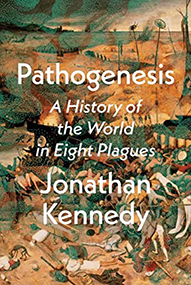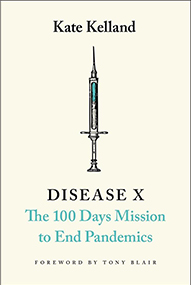May 24, 2023
COVID-19 is no longer an emergency, but its lessons better linger
Two new books illustrate why reflection and preparation are both essential to ensure a quicker and more equitable response to the next pandemic.
Kristen Kresge Abboud
We’ve become quite used to describing the COVID-19 pandemic with terms like “unprecedented,” or referring to it as a once-in-a-century occurrence. But what is most remarkable about COVID-19 isn’t that it happened. It’s that we were so unprepared when it did.
“When we place coronavirus in its historical and scientific context, it becomes very clear that there is very little about it that is new or remarkable,” writes Jonathan Kennedy in his new book Pathogenesis: A History of the World in Eight Plagues. “Recurring outbreaks of infectious disease have been a feature of human existence for millennia.”
 Pathogenesis: A History of the World in Eight Plagues
Pathogenesis: A History of the World in Eight Plagues
By Jonathan Kennedy. 304 pages. Crown.
Kennedy teaches politics and global health at Queen Mary University of London and is co-deputy director of the University’s Centre for Public Health & Policy. His varied research topics include the link between vaccine hesitancy and populist politics in Europe and the impact of drone strikes on polio eradication efforts in Pakistan. In Pathogenesis he provides a thorough investigation of how infectious diseases have shaped human history. Spoiler alert: the answer is quite profoundly. “Pathogens have been the protagonists in many of the most important social, political, and economic transformations in history,” he writes.
Kennedy contends that epidemics of infectious diseases played a vital role in, among other things, the reign of Homo sapiens and their overtaking all other human species, the rise and fall of the world’s great empires, the dominance of Christianity and Islam in world religion, the devastation that resulted from European colonialism, and the emergence of American slavery. It sounds like a lot to pin on these tiny microbes, but Kennedy articulates his arguments with such assuredness that it begins to make you wonder why anyone was surprised when our lives were so dramatically uprooted by SARS-CoV-2. In fact, Kennedy makes it clear in the introductory pages of the book that his goal is to “convince you that the modern world has been shaped by microbes as much as by women and men.”
And he asserts that this will continue to be the case. “The last fifty years have turned out to be a golden age for infectious diseases,” he writes, citing the emergence of HIV/AIDS, SARS, Zika, and COVID-19. He attributes the abundance of new pathogens to the usual suspects — population growth, climate change, the increased ease of travel, etc. — and he also sounds familiar alarm bells about what the future may hold.
“Humans are in a very precarious position. We live on a planet that is by almost any measure dominated by microbes,” which intriguingly he notes are so numerous that the total mass of microscopic bacteria that populate the planet is 35 times more than all animals on Earth, and 1,000 times the weight of all humans! “We are surrounded by innumerable viruses and bacteria that are mutating all the time. Some are evolving in ways to help us. Others are developing new ways to harm us,” he warns.
Lest that lead you to believe we have no control over our destiny, Kennedy argues that COVID-19 represents a “crucial inflection point” in the story of human life on the planet. His advice, perhaps not surprisingly, is that the best way forward is to reflect on our historical relationship with bacteria and viruses and take inspiration from the fact that past pandemics have been the driver of important social, economic, and political transformations.
Perhaps COVID-19 will do the same, but it isn’t clear yet precisely how. This author hopes that one of the ways COVID will shape our future is to inspire humanity to, quite simply, work more collaboratively to address the stark health disparities that the COVID-19 pandemic laid bare.
“Pathogens thrive on inequality and injustice,” he writes. “In order to prepare society to be resistant to future pandemics, it is crucial to address the more fundamental problems that make some people more vulnerable to infectious diseases than others. It is now up to us to seize the opportunity to address these iniquities and to build a happier and healthier world.”
While Kennedy’s book barely even scratches the surface on how to do that, another new book by Kate Kelland — Disease X: The 100 Days Mission to End Pandemics — dives into this issue in detail.
 Disease X: The 100 Days Mission to End Pandemics
Disease X: The 100 Days Mission to End Pandemics
By Kate Kelland. 206 pages. Canbury Press.
Kelland, a former global health correspondent for Reuters, is currently the chief scientific writer at the Coalition for Epidemic Preparedness Innovations (CEPI), a non-profit organization established in the wake of the 2014-2015 Ebola epidemic with the goal of developing vaccine candidates against pathogens with pandemic potential. One of these was given the designation of Disease X by the World Health Organization (WHO), a moniker for a previously unknown disease that could lead to an international epidemic. SARS-CoV-2 was of course one Disease X.
There will be others.
CEPI’s goal now is to capitalize on what worked astoundingly well with the COVID-19 response — the rapid development, manufacturing, and deployment of highly effective vaccines against a previously unknown foe — and make it even faster, more efficient, and more equitable the next time around.
From January 2020 to January 2022, 10 billion doses of COVID-19 vaccine were delivered across the globe, according to Kelland, amounting to what she calls “humanity’s greatest ever collective scientific and public health achievement.”
She spends most of the book recounting what went right and what went wrong with the world’s response to SARS-CoV-2, and if you’ve read other pandemic books in the past couple of years, much of this will be a rehash, albeit with much more of the focus here on CEPI’s role in coordinating and responding to the pandemic from its earliest moments.
But what Kelland takes the reader through is what she sees as the necessary components to ensure that the next Disease X never even reaches the point of becoming a pandemic. Containment is key. And the keys to containment, as she outlines in the book, are primarily speed, collaboration, success, and investment.
“Moving on from the likes of Warp Speed,” she says, referring to the U.S. government’s name for its effort to develop diagnostics, vaccines, and therapeutics for COVID-19 faster than ever before, “to ‘Pandemic Speed’ — a next-level pace of scientific and societal progress that will take the world ahead of infectious disease outbreaks so that we can safely defend ourselves and our way of life against them.”
This is where CEPI’s 100-day mission comes into play, a proposition initially made in early 2021 and subsequently backed by the G7 nations and G20 governments. Developing new vaccines in 11 months, as occurred with SARS-CoV-2, was impressive; doing it in just over three months may sound too optimistic. But Kelland and others argue it isn’t. In the book, Eric Lander, a mathematician and geneticist who served as director of the Office of Science and Technology Policy and science advisor to U.S. President Joe Biden, calls the 100-day target feasible.
The most intriguing part of Disease X: The 100 Days Mission to End Pandemics is undoubtedly the last chapter. It is a fictional take on how the 100-day mission plays out in 2027 when an entirely new pathogen that bears similarities to the parmyxovirus Nipah is identified in young children in the city of Kompang Chom, Champosa.
Information about the new pathogen is communicated rapidly among local health officials and then to a WHO pandemic hub. Four days later the full genetic sequence of this new virus, which comes to be known as Pechong virus, is published on a public database. That quickly, vaccine development efforts are started. Multiple vaccine constructs are generated based on prototype vaccines that are already available in the fictional Global Library of Innovations for Pandemic Prevention, or GLIPP.
Targeted lockdowns are instituted initially, and then by day nine, the entire nation of Champosa is quarantined to rapidly tamp down spread of the new pathogen.
In response to COVID-19, G20 countries and the World Bank made substantial investments to expand vaccine production capabilities across the globe and these are ready to be employed in response to this new viral threat. Given the “deadly and pandemic potential of the new Disease X,” the fictional G20 leaders also vote to deploy U.S.$20 billion they had reserved for at-risk development, manufacturing, and procurement of six Pechong virus vaccines. Reserves of clinical trial volunteers who were already established as part of the Pandemic Speed initiative are ready to enroll in vaccine trials.
Two months later, after twists and turns with the different vaccine platforms, the potential pandemic of Pechong virus is thwarted.
The 100-day mission is complete and a pandemic, the likes of which the world hadn’t seen since COVID-19, was averted because effective vaccines were administered where and when they were needed most to contain the outbreak before it spiraled out of control. There was no greedy stockpiling of vaccines by wealthy countries or campaigns of misinformation. It is a powerful way to explain what the future could be like if the lessons of COVID-19 aren’t forgotten.
In this case it may be fiction, as much as history, that shows us how we can best prepare for and prevent future pandemics.
See CEPI’s press release about the publication of Disease X: The 100 Days Mission to End Pandemics.